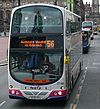
Ashton Park Parade railway station was a station on the line between Guide Bridge and Stalybridge in Greater Manchester, England. This station served the town of Ashton-under-Lyne, now served only by Ashton Charlestown, north of this former station.

Ramsbottom railway station is a heritage station serving the town of Ramsbottom in Greater Manchester, England.

Stockport Portwood railway station was a railway station in Stockport, England on the Stockport and Woodley Junction Railway

Swanbourne was a railway station that served the villages of Swanbourne, Little Horwood and Mursley in north Buckinghamshire, England. It was on the mothballed Bicester to Bletchley line, roughly at the centre of a triangle drawn between the three villages. In summer 2020, the station was demolished to clear the route for East West Rail.

Abergavenny railway station was a station on the London and North Western Railway's Heads of the Valleys line serving the town of Abergavenny in the Welsh county of Monmouthshire.
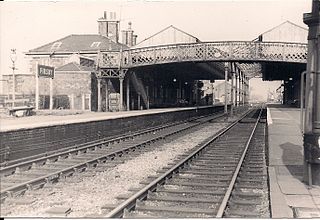
Firsby railway station was a station in Firsby, Lincolnshire. It served as a main line station and a terminus for two branch lines to Skegness and Spilsby respectively. The station was popular in the 19th and early 20th centuries for seaside connections to Skegness, but was recommended for closure in the Beeching Report and closed in 1970. The station was mostly demolished.

Wartle railway station was a railway station that served local farms and the nearby hamlet of Meikle Wartle, Aberdeenshire. It was opened in 1857 by the Banff, Macduff and Turriff Junction Railway, later part of the Great North of Scotland Railway, then the LNER and finally British Railways, on the 29+3⁄4-mile (47.9 km) long branchline from Inveramsay to Macduff. The station closed to regular passenger services in 1951 and to goods traffic in 1964.
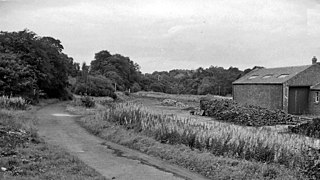
Balerno railway station was opened in 1874 and served the area of the village of Balerno that now forms part of the city of Edinburgh. Although primarily built as a goods line, with a dedicated goods station at Balerno, serving the many mills on the Water of Leith, a passenger service was provided by the Caledonian Railway using the Balerno Loop and after grouping by the London, Midland and Scottish Railway, seeing formal closure to passenger traffic shortly after nationalisation. The station was the only one with a separately served goods station on the 'loop' line and lay in rural surroundings that had been popular with families having a day out in the country.

South Leigh railway station was a single-platform station that served the Oxfordshire village of South Leigh on the Oxford, Witney and Fairford Railway between Oxford and Witney. The Witney Railway opened the station in 1861. British Railways closed the station to passengers in 1962 and to goods in 1965.

Eynsham railway station served the Oxfordshire town of Eynsham and the Eynsham Sugar Beet Factory on the Oxford, Witney and Fairford Railway between Oxford and Witney.
Witney goods station served the Oxfordshire town of Witney on the Oxford, Witney and Fairford Railway. It consisted of seven sidings, a goods shed, a wooden parcel office and a cattle dock. It also had an engine shed, which was demolished early in the twentieth century. Following the opening of the East Gloucestershire Railway in 1873, the station became a goods depot, with passengers using the second station situated to the south. The original station remained open to goods traffic until 1970.
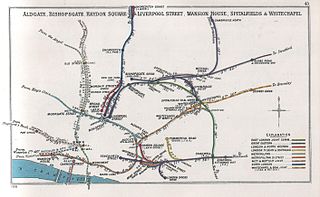
Globe Road & Devonshire Street was a railway station on the Great Eastern Main Line, 1 mile 54 chains (2.7 km) down the line from Liverpool Street. It was opened by the Great Eastern Railway on 1 July 1884 when the company quadrupled the double-track main line section, and it was situated close to the site of the former Devonshire Street terminus, which had closed in 1840.

Trusham Railway Station was a railway station in the parish of Chudleigh, serving the villages of Trusham and Hennock in Devon, England, on the Teign Valley line between Newton Abbot and Exeter.

Turvey was a railway station on the Bedford to Northampton Line which served the village of Turvey from 1872 to 1962.

Currie railway station was opened in 1874 and served the area of the village of Currie that now forms part of the city of Edinburgh. Although primarily built as a goods line to serve the many mills on the Water of Leith, a passenger service was provided by the Caledonian Railway using the Balerno Loop and after grouping by the London, Midland and Scottish Railway, seeing formal closure to passenger traffic shortly after nationalisation. The station was the largest on the 'loop' line and lay in rural surroundings and had once been popular with families having a day out in the country.

Torrance railway station was opened in 1879 on the Kelvin Valley Railway and served the area of the village of Torrance in East Dunbartonshire until 1951 for passengers and 1959 for freight.

Balmore railway station was opened in 1879 on the Kelvin Valley Railway and served the coal mining area, farms and the village of Balmore in East Dunbartonshire until 1951 for passengers and to freight on 31/7/61.
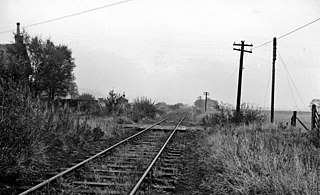
Bardowie railway station was opened in 1905 on the Kelvin Valley Railway, later than most of the other stations which had opened with the line itself in 1879. It served the hamlet of Bardowie and the coal mining area, farms, etc. in East Dunbartonshire until 1931 for passengers and to freight on 31 July 1961.
Leadhills railway station was opened on 1 October 1901 as the intermediate stop on the Leadhills and Wanlockhead Light Railway and served the lead mining area, farms and the village of Leadhills circa 5.5 miles (8.9 km) WSW of Elvanfoot railway station in South Lanarkshire until 2 January 1939 for passengers and freight. Until Wanlockhead station opened Leadhills was the highest standard gauge adhesion station in the United Kingdom.

Wilsontown railway station was the passenger terminus of the three and three quarter mile long Wilsontown Branch that ran from a bay platform at Auchengray railway station and served the nearby village of Wilsontown in Lanarkshire and several collieries. The only other station on the line was at Haywood, standing two miles from Auchengray on a double track section of the line. Apart from the collieries this was a mainly farming district at the times of the railway's construction.



















